The Best Golf Course No One Will Ever Play
by
Richard Mandell
For over a year now I have lamented over a project I lost out to a former PGA Tour great and his main Architect. This is after months of assuring me the project did not need a ‘name’ to stand on, which I questioned from the onset. The Client, in passing, said both our routings were pretty much the same and it didn’t matter too much. The main reason the Client chose the Architect was for permitting experience. This particular Architect successfully permitted a golf course project in the next town over. So for convenience’ sake, there will be two very high end daily fee golf courses by the same architect in two towns bordering each other. Never mind that I have successfully permitted a golf course project in the same county, dealing with the exact same government agencies beyond the local town board.
The Client shared the other routing with me and I can only say there IS a big difference between the layouts. Once again strategic design and the utilization of natural landforms have been completely overlooked by a developer who does not understand what golf course architecture is all about. Instead, perceived ease of development takes center stage. Yet this will require more construction costs up front as more dirt will be moved and more drainage needed. This is a common thread many of us encounter in the business and has been a consistent topic on GolfClubAtlas over the years. I present this routing purely from a ‘love of the art of golf course routing’ perspective and nothing more.
I will only say that the site is in the northeastern United States and is the best site I have ever seen for a golf course that does not have ocean or other distinguishing landforms. For the past twelve months, I have not been able to get the site out of my mind. Walking the site was an incredible experience. It was the singular most enjoyable routing exercise I have undertaken to date, yet no one will ever get to see it. Until today. Only our regular GCAers will appreciate what I am about to reveal and thank God there are nuts like me that would appreciate something like this routing. Allow me to present with the utmost humility, ‘The Best Golf Course No One Will Ever Play‘.
Following is an excerpt directly from my design services proposal describing the golf course routing. The name of the site has been changed simply to ‘The Property’.
‘The Property’ is clearly the best piece of property I have ever seen for a golf course site. In describing great golf course sites (before or after construction), the common denominator that all great sites and courses possess is VARIETY. It is at ‘The Property’ that this is most evident. The variation in topography is unmatched not just in dramatic ravines to utilize, existing water bodies nor even elevation changes, but mostly in the characteristics that the great links courses of the British Isles possess.
Although ‘The Property’ site is far from a links site, the dominant features of the site are what I call the ‘rolling flats’ found throughout the site. The rolling flats can best be described as little knobs, knolls, plateaus, swales, saddles, and ridges that stretch up and down the property. In addition to the rolling flats, the site has wonderful ridge lines to play off as well as the aforementioned ravines and water bodies. This all constitutes tremendous variety.
My routing philosophy is based upon routing golf holes from high point to high point to high point. In other words, the tees, landing areas, and greens all are located on high spots, allowing natural drainage patterns uninterrupted flow in non-play areas. This is built-in surface drainage. A result are a minimum of seasonal wet areas, less cost in redirecting drainage and less earthwork to make golf course features visible. This is how the great architects of the past routed such natural appearing layouts, truly allowing the site to dictate the golf.
‘The Property’ site has allowed me to do just that: let the site dictate the golf. This is in extreme opposition to the more accepted modern philosophy of today’s architects, who insist on imposing upon the site their own version of a golf course. By allowing the site to dictate the golf, one can properly capture the character of the area, minimize costs, and maximize success.
In addition to variety, the key to a successful golf course design is ensuring that each golf hole has strategic merit. When a site helps create that strategic merit, the project will be elevated to the highest level of golf course design. There is no need to move dirt to create strategy as with other sites. Strategy is already present at ‘The Property’.
The routing for ‘The Property’ maximizes natural flats and ridges for landing areas, natural saddles, ridges, and knobs for greens; and natural knolls and high points for tee boxes. It is the land forms between these areas which reveal strategic and heroic (and a few penal) design opportunities.
In addition to maximizing the natural land forms of ‘The Property’ site, I have chosen to avoid questionable areas which may require an excess of construction effort or environmental strangleholds. I have also considered the composition of the land for future development. At such a conceptual stage, I decided to avoid the forty-six acre tract to the north for three reasons: Save it in its entirety for another use; eliminate the need to cross under the power easement; and minimize the permit process at this stage by keeping the golf course off ‘Adjacent Town’ land. I also completely avoided the wetlands to the southeast. In addition, most golf is avoided on the severe slope that runs the west to east axis of the property to minimize earthwork, eliminate poorly fitted golf holes, and minimize environmental concern. The slope is addressed by teeing off above it to a fairway below or playing to the base of the slope and allowing only for travel to the next tee.
I have incorporated the preferred hotel site into the routing as the start and finish of the golf course, without returning nines. Because the site is mostly linear, it would be more difficult to have two nine-hole loops return to the hotel site. If this was done, many great natural golf holes would be sacrificed and the cost of the golf course would increase unnecessarily. From an operational standpoint, it is a theory of ‘stepping over dollars to make pennies’. Returning nines would ruin the potential of the site. My vision for this golf course is to provide a dramatic congregation point for golfers and hotel/conference center visitors overlooking the golf course below. This point is where I have placed the practice putting green.
All great golf courses possess another type of variety. VARIETY in strategy is the component of design that elevates the best from the rest. When a site dictates that variety, it has few rivals. Strategy can simply be defined as an Architect utilizing hazards in order to create a stratagem or device to challenge a golfers’ thought process as well as physical ability in beating par. Strategy is the soul of the game of golf and without strategy a golf course may be a ‘walk in the park’, but nothing else. From an economic standpoint, strategy designed correctly equates to challenge to the golfer which equates to a variety of options for the golfer to make choices. The variety of choices is what creates repeat play and memorable experiences.
Strategy = Challenge = Options = Choices = Repeat Play
When reviewing the hole -by-hole description of my conceptual routing, keep in mind the variety of strategy described in each hole and how that variety of strategy is revealed through the site characteristics of ‘The Property’ property. Also note the variety in the use of different natural features in creating strategic alternatives. This is why your site is destined for greatness that even the biggest names in golf design may not uncover.
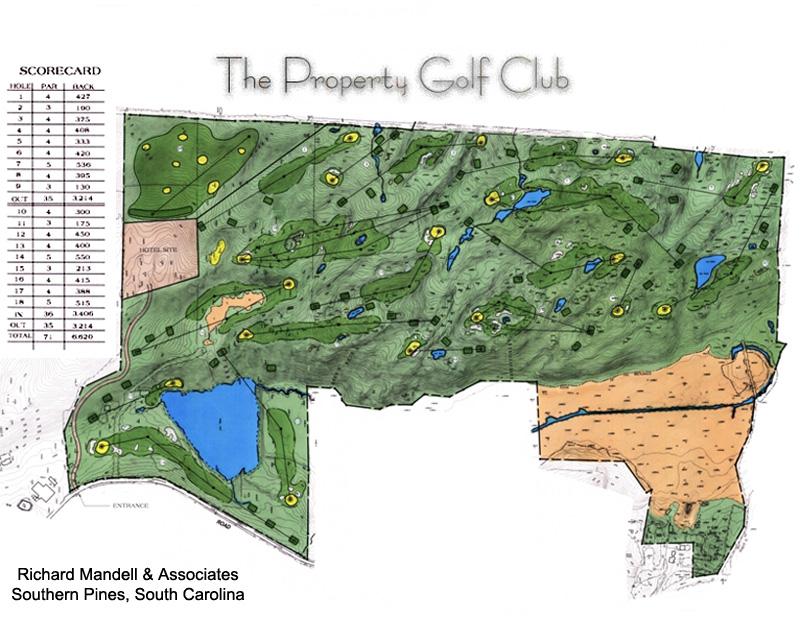
Hole #1, Par 4, 427 yards
The first hole is a simple downhill par four with the landing area along the flatter area of the ridge it follows to a green placed on a natural saddle. There are no sand bunkers on the hole for a few reasons. The first is to give a positive beginning to the round, the second being the fact that any fairway sand bunkers would be blind unless enough dirt was moved. Then one would be left with a glaring artificiality to the hole. The green setting has its own natural challenges.
Hole #2, Par 3, 190 yards
Hole number two is the first of four par threes which all play to a variety of yardage and directions, hallmarks of a great golf course routing. The golfer tees off a natural knob over a creek uphill into the flatter part of the downhill ridge.
Hole #3, Par 4, 375 yards
This dogleg right par four plays back downhill over the creek to a natural plateau facing the tee. The approach is hit over a ridge of dunes and a ravine to the top of another ridge. The tee shot can cut the dogleg corner along the dune, one of many holes where the lay of the land creates the strategy for the golf hole.
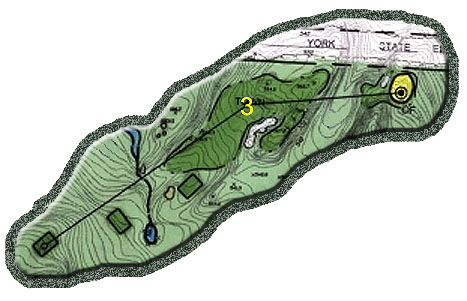
Hole #4, Par 4, 407 yards
This dogleg right par four plays off the same natural dune as the third green. The landing area is located on another natural plateau and the approach plays through two existing knobs to the right of a ravine. The green sits on the side of a nose set into the side of the ravine.
Hole #5, Par 4, 333 yards
The fifth hole is a classic, heroic, ‘bite off as much as one can chew’ golf hole. The strategy calls for the golfer to cut the dogleg left for reward equivalent to the risk. The tee shot plays off a ridge downhill over a ravine to naturally rolling land forms. The approach is played to a natural saddle point for the green. This strategy is similar to that of hole number three, but it utilizes a different natural landform to create strategy for the golfer.
Hole #6, Par 4, 420 yards
This hole is a dogleg right with the tee shot off a natural highpoint through rolling flats to an undulating plateau. A pond acts as a turning point in the dogleg, rewarding the golfer with a shorter approach the closer the tee shot is played to the water. This is another heroic golf hole utilizing the natural land forms in a different way. The approach is uphill over a ridge to a green found in a natural flat.
Hole #7, Par 5, 536 yards
Like the par threes and fours, this is the first par five of varying length. The dogleg left begins with a tee shot from a highpoint over the ravine to more rolling flats. There is a choice off the tee of cutting the dogleg down a natural ridge to another flat area. The choices for the second shot increase with the opportunity to play left of the water (an open, longer shot), right of the water (shorter, yet slightly obscured), or over the water. The green is located at the base of an uphill ridge. Number seven is the first of many holes which incorporates an existing central cross hazard to determine strategy for the golfer.
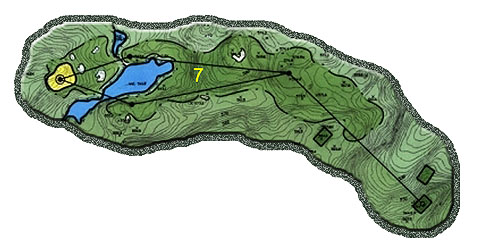
Hole #8, Par 4, 390 yards
Hole number eight is a dogleg left that plays back off the hillside up to a natural rolling plateau. The approach is played over a depression to a natural highpoint. The topography again allows the golfer to cut the inside corner to gain an advantage.
Hole #9, Par 3, 130 yards
The shortest hole on the course, number nine is a perfect connector hole that plays over the ravine. The hole is placed on a diagonal to create a variety of length options from tee to green. The further to the right the pin may be, the more the ravine becomes a dangerous factor.
Hole #10, Par 4, 300 yards
Deliberately designed to be a short par four, this hole challenges the golfer to gain as much as one chooses off the tee, or lay up for a proper approach. Utilizing the rolling features of the land to create a central hazard, the tee shot can be played off an existing nose over the ravine to a natural ridge running all the way to the green. The golfer can be more daring by playing further left to the lower fairway, over sand and uphill to the green. This will reward the golfer with a shorter second shot, yet with more risk. The basic concept here is that the golfer can play anywhere from the right side (safe) to the left side (riskier) based upon the natural lay of the land and the golfer’s own ability.
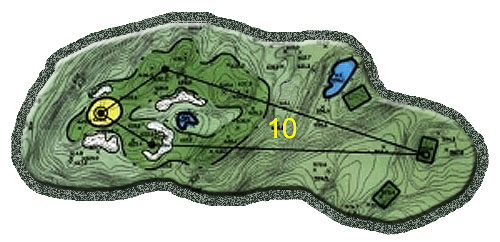
Hole #11, Par 3, 175 yards
The eleventh hole shares the same characteristics of one of the most replicated strategic par three in the world, the Redan at North Berwick. The strategy of the Redan is to bounce a tee shot into a green running from a high point front right to a low point back left. If the golfer tries to hit a tee shot directly at the flag, odds are that the natural slope of the green will run the ball away from the pin location that day. This hole will play off a hillside over the ravine to a natural ridge which already has a Redan appearance before any dirt is moved.
Hole #12, Par 4, 450 yards
Number twelve plays off a dune on the far side of a steep swale along a ridge line to another area of rolling flats. The hole continues along this ridge downhill to a natural saddle green location. A long par four works well here as there are few natural areas where a hole this long can fit into the natural topography of the property. The same is true for the par fives on the property as well.
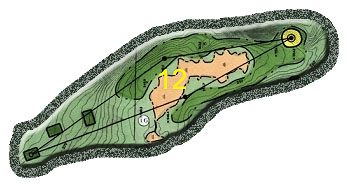
Hole #13, Par 4, 400 yards
This hole layout allows us to avoid troublesome earthmoving and environmental concerns by avoiding the severe slope that runs the length of the property. By placing the tee on top of the hill and the fairway below, the integrity of the land is properly preserved and unflattering playing conditions are avoided. The remaining tee boxes can nestle along the slope. It is much easier to place tee boxes here instead of a landing area or green. Thirteen is a downhill dogleg right over the pond to a landing area behind the dam. The approach is uphill to a perfectly set natural green location. Both sides of the fairway provide great opportunity to create additional wetland areas.
Hole #14, par 5, 550 yards
The longest hole on the golf course fits perfectly in this corner of the property. The dogleg left par five plays off a ridge downhill to a narrow neck pinched by the property boundary on the left and the pond to the right. This is another natural feature of the property that helps create strategy in a way that has yet to be explored (variety). The second shot can be played off the ridge to the left which protects the shortest route to the green. One can choose to take the longer route to the right. It may not be the safest, though, as the pond comes more into play in that direction. The green site is the first glimpse guests to the property have as they enter the site off the road. Right away the golfer’s juices begin to flow as more of hole fourteen is slowly revealed.
Hole #15, Par 3, 213 yards
The visitor’s excitement builds as they begin the ride to the hotel site. They can see directly along the tee complex set into the hillside of hole fifteen. This is the longest par three on the property and plays to the base of the steep slope, yet overhangs the pond. The water becomes less of a factor for the less-skilled golfers as the tee boxes array around the green along the slope.
Hole #16, Par 4, 415 yards
The excitement of the entrance road for golfers and non-golfers alike continues uphill as the decisions to be made on sixteen catch their attention. Avoiding most of the steep slope below, the tee complex is set along the flat above. The golfer can choose the more direct, yet dangerous, route over the existing wetlands. Or the golfer can choose the safer route along the ridge to the left of the wetlands. The green sits on a natural knob awaiting either choice, but beware the angle of play to the green for the more conservative choice. This is yet another natural feature which determines the strategy of a golf hole at ‘The Property’.
Hole #17, Par 4, 390 yards
This golf hole begins off the side of a hill through rolling flats to a natural ridge. The second shot plays along the ridge to a green set on an up slope beyond a natural saddle. With a little effort, one can create a split fairway with a longer, higher route and shorter, lower choice. Similar to hole number twelve and many others, this hole runs naturally along a ridge line, minimizing the perceived amount of required earthwork.
Hole #18, Par 5, 515 yards
The climax of the routing is reached with the last par five on the golf course. In wrapping up the strategic theme of this layout, the golfer has many choices from tee to green. The sister hole to eighteen is number ten, although they appear as polar opposites. They share the same strategy that challenge and danger increases from one side of the hole to the other. The golfer can play the safe, longer way down the left side which will open up views of the hole from tee to green. Or the golfer can play far right over a ridge to a small landing area. From this side, the golfer can get home in two, but the route is blind and has the most hazards to negotiate. The further left to right the golfer chooses as the desired route, the more blind and dangerous the route becomes. The second landing area lies just beyond a natural mound complex (another existing central hazard) in the middle of the fairway. The more open route is just left of the mound complex, following a natural ridge line. The green sits atop a natural saddle at the base of the ridge where the hotel sits. The practice green overlooks the final green in a natural amphitheater setting.
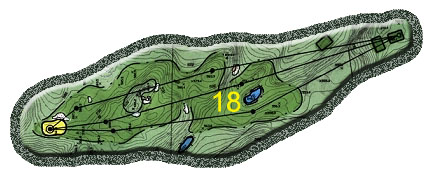
The End







